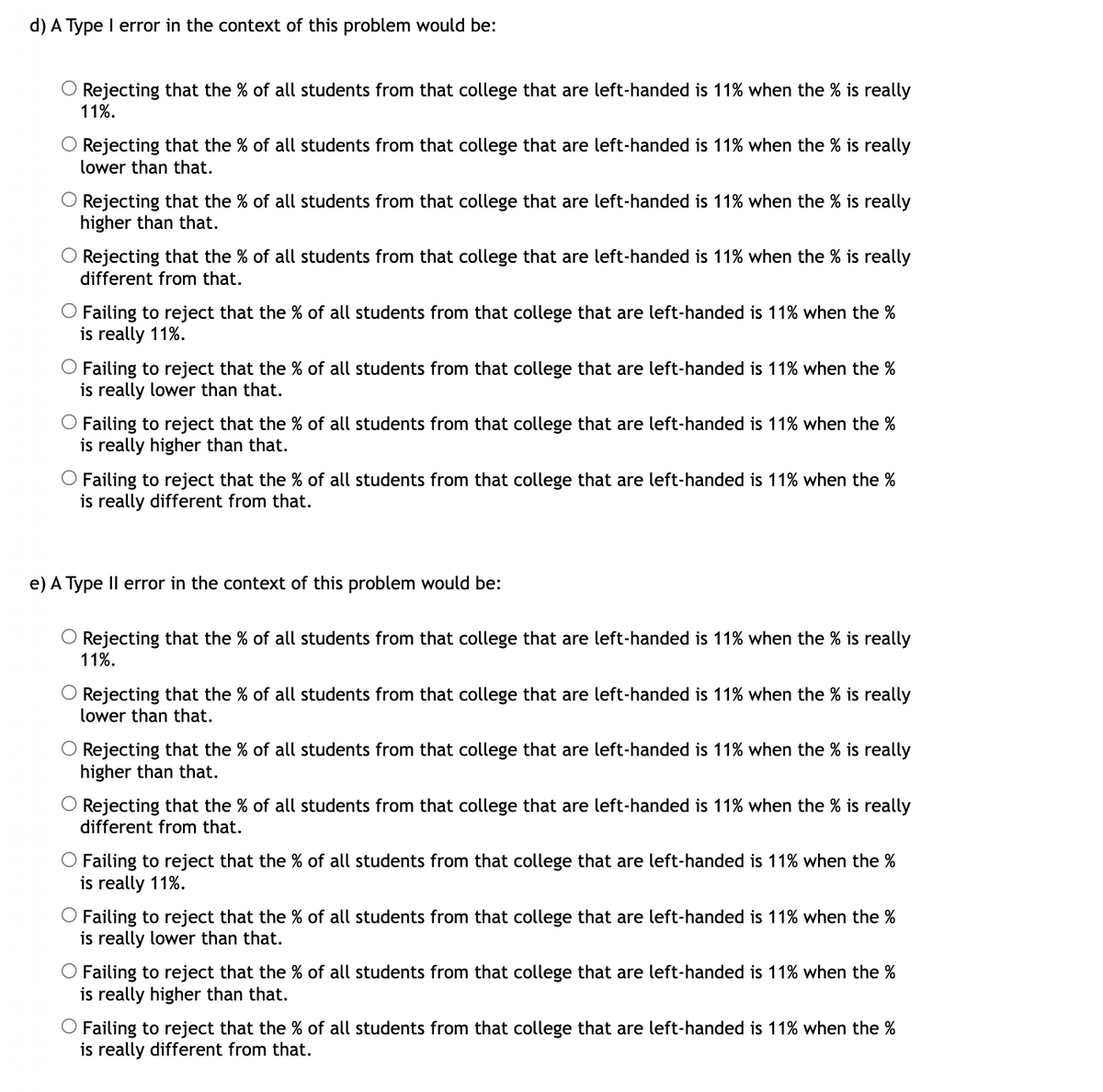It is believed that 11% of all Americans are left-handed. A college needs to know how many left-handed desks to place in the big lecture halls being constructed on its campus. In a random sample of 210 students from that college, whether or not a student was left-handed was recorded for each student. The college wants to know if the data provide enough evidence to show that students at this college have a higher percentage of left-handers than the general American population? State the random variable, population parameter, and hypotheses. State the Type I and Type II errors in the context of this problem.
It is believed that 11% of all Americans are left-handed. A college needs to know how many left-handed desks to place in the big lecture halls being constructed on its campus. In a random sample of 210 students from that college, whether or not a student was left-handed was recorded for each student. The college wants to know if the data provide enough evidence to show that students at this college have a higher percentage of left-handers than the general American population? State the random variable, population parameter, and hypotheses. State the Type I and Type II errors in the context of this problem.
Holt Mcdougal Larson Pre-algebra: Student Edition 2012
1st Edition
ISBN:9780547587776
Author:HOLT MCDOUGAL
Publisher:HOLT MCDOUGAL
Chapter11: Data Analysis And Probability
Section: Chapter Questions
Problem 8CR
Related questions
Question

Transcribed Image Text:d) A Type I error in the context of this problem would be:
O Rejecting that the % of all students from that college that are left-handed is 11% when the % is really
11%.
O Rejecting that the % of all students from that college that are left-handed is 11% when the % is really
lower than that.
O Rejecting that the % of all students from that college that are left-handed is 11% when the % is really
higher than that.
O Rejecting that the % of all students from that college that are left-handed is 11% when the % is really
different from that.
O Failing to reject that the % of all students from that college that are left-handed is 11% when the %
is really 11%.
O Failing to reject that the % of all students from that college that are left-handed is 11% when the %
is really lower than that.
O Failing to reject that the % of all students from that college that are left-handed is 11% when the %
is really higher than that.
Failing to reject that the % of all students from that college that are left-handed is 11% when the %
is really different from that.
e) A Type II error in the context of this problem would be:
O Rejecting that the % of all students from that college that are left-handed is 11% when the % is really
11%.
O Rejecting that the % of all students from that college that are left-handed is 11% when the % is really
lower than that.
O Rejecting that the % of all students from that college that are left-handed is 11% when the % is really
higher than that.
O Rejecting that the % of all students from that college that are left-handed is 11% when the % is really
different from that.
O Failing to reject that the % of all students from that college that are left-handed is 11% when the %
is really 11%.
O Failing to reject that the % of all students from that college that are left-handed is 11% when the %
is really lower than that.
O Failing to reject that the % of all students from that college that are left-handed is 11% when the %
is really higher than that.
Failing to reject that the % of all students from that college that are left-handed is 11% when the %
is really different from that.

Transcribed Image Text:It is believed that 11% of all Americans are left-handed. A college needs to know how many left-handed
desks to place in the big lecture halls being constructed on its campus. In a random sample of 210 students
from that college, whether or not a student was left-handed was recorded for each student. The college
wants to know if the data provide enough evidence to show that students at this college have a higher
percentage of left-handers than the general American population? State the random variable, population
parameter, and hypotheses. State the Type I and Type II errors in the context of this problem.
Expert Solution
This question has been solved!
Explore an expertly crafted, step-by-step solution for a thorough understanding of key concepts.
This is a popular solution!
Trending now
This is a popular solution!
Step by step
Solved in 3 steps

Recommended textbooks for you

Holt Mcdougal Larson Pre-algebra: Student Edition…
Algebra
ISBN:
9780547587776
Author:
HOLT MCDOUGAL
Publisher:
HOLT MCDOUGAL


College Algebra (MindTap Course List)
Algebra
ISBN:
9781305652231
Author:
R. David Gustafson, Jeff Hughes
Publisher:
Cengage Learning

Holt Mcdougal Larson Pre-algebra: Student Edition…
Algebra
ISBN:
9780547587776
Author:
HOLT MCDOUGAL
Publisher:
HOLT MCDOUGAL


College Algebra (MindTap Course List)
Algebra
ISBN:
9781305652231
Author:
R. David Gustafson, Jeff Hughes
Publisher:
Cengage Learning